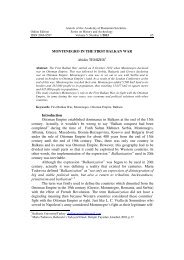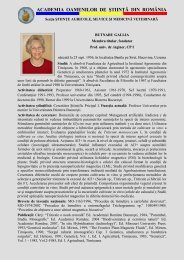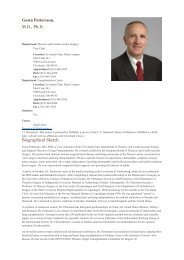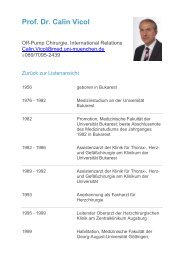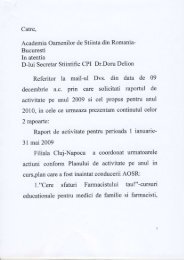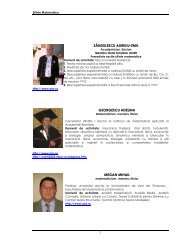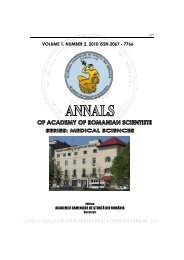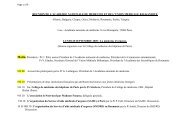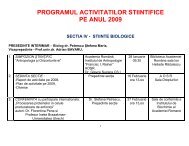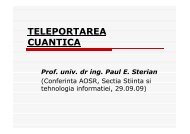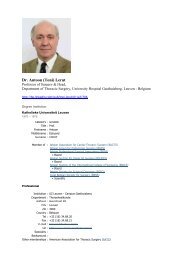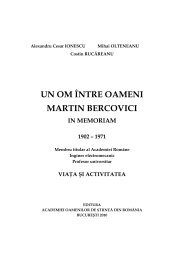Ion V. Popescu, Cristiana Radulescu, Claudia Stihi,44 Gabriela Busuioc, Anca Irina Gheboianu, Valerica Gh. CimpocaThe mean concentration of heavy metal (Cd, Cr, Ni, Pb, Ti, Sr, Co, Bi) was higherat mushrooms which were collected on forest sites near urban settlements inDambovița County, as well. The highest cadmium content was observed in toxicspecies Hypholoma fasciculare (0.35 mg/kg d.w.) and Amanita phalloi<strong>de</strong>s (0.30mg/kg d.w.); the higher chromium level was obtained in Armillariella mellea(1.10 mg/kg d.w.) and nickel was foun<strong>de</strong>d in high concentration in Hypholomapudorinus (1.54 mg/kg d.w.).The amount of lead was higher in Amanita vaginata, Amanita phalloi<strong>de</strong>s,Armillariella mellea, Armillariella tabescens, Agricus campestris and smaller inAmanita rubescens, Hypholoma fasciculare and Hypholoma pudorinus. Lowestlevel of heavy metals is foun<strong>de</strong>d in Hypholoma pudorinus because the mountainforest soil, with pH 5.20, was low in heavy metals as well. This forest sites are inan area without industrial and traffic pollution.All the wild toxic species, Amanita phalloi<strong>de</strong>s, Hypholoma pudorinus,Hypholoma fasciculare and Agricus campestris accumulated Co and Ti from soilin low concentrations. The Co and Ti level in non-toxic species, as Amanitavaginata, Amanita rubescens, Armillariella mellea and Armillariella tabescens,could not <strong>de</strong>termine by FAA spectrometry. In this case, to <strong>de</strong>termine the level ofCo and Ti in non-toxic mushrooms the Solid Sampling Graphite Furnace AtomicAbsorption Spectrometry (SS-GFAAS) can be applied.The bismuth amount in some mushrooms species and their substrate can be<strong>de</strong>termined by Solid Sampling Graphite Furnace Atomic Absorption Spectrometry(SS-GFAAS) as well.The studied mushrooms are very good bioaccumulators of zinc, calcium,magnesium, selenium and cupper; the smaller affinity for titanium, strontium andbismuth was observed at all studied wild mushrooms (Table 2).In the soil samples collected at forest sites near industrial urban (pH weakly acid)it was observable a higher amount in iron, zinc, lead, manganese and chromium.The results of this study showed the fact those wild toxic mushrooms species aremetal bioaccumulators. Heavy metal contents of all analyzed mushrooms weregenerally higher than previously reported in literature. For example, a highestaccumulation of Fe, Cu, Mg and Zn from substrate was observed for all theanalyzed mushrooms samples. Furthermore, a high accumulation of Pb, Cd and Crwas observed in mushrooms growing Amanita and Armillariella species bycompared with Commission Regulation (EC) No 1881/2006 of 19 December 2006[17] setting maximum levels for certain contaminants in foodstuffs: section 3 –Metals Vegetables, exclu<strong>din</strong>g brassica vegetables, leaf vegetables, fresh herbs andfungi.Copyright © Editura Aca<strong>de</strong>miei <strong>Oamenilor</strong> <strong>de</strong> Știință <strong>din</strong> România, <strong>2011</strong>Watermark Protected
ConclusionsThe Study of Heavy Metal from Environmental Samples by Atomic Techniques 45Generally, the studied mushrooms contained minerals required in the human diet,such as Fe, Zn, Mn, Cu, Cr and Se and also the mainly toxic elements, such as Cd,Ni and Pb. The level of toxic elements was lower than that of minerals.The weakly acid pH value of soil influenced the accumulation of zinc insi<strong>de</strong>studied mushrooms species.The concentrations obtained for heavy metals in non-toxic species seems to beacceptable for human consumption and nourishment value.Analytical possibilities of EDXRF and AAS analytical methods were comparedand the heavy metal transfer from substrate to mushrooms was studied.The results of this study showed the fact those wild toxic mushrooms species aremetal bioaccumulators. Heavy metal contents of all analysed mushrooms weregenerally higher than previously reported in literature.In <strong>Romania</strong> is the first study which following to i<strong>de</strong>ntifier the mushroom specieswhich accumulated heavy metals from forest sites near polluted cities inDambovița County.AcknowledgmentThe researches were performed in the frame of the Project PN-II-ID-PCE-2008-72 172.R E F E R E N C E S[1] KALAC P., SVOBODA L., A review of trace element concentrations in ediblemushrooms, Food Chem., 69, 273-281 (2005).[2] ANTONIJEVIC M.M., MARIC M., Determination of the Content of Heavy Metals inPyrite Contaminated Soil and Plants, Sensors, 8, 5857-5865 (2008).[3] YILMAZ F., ISILIGLU M., MERDIVAN M., Heavy metals levels in some macrofungi,Turk J. Bot. 27, 45-56 (2003).[4] KALAC P., BURDA J., STASKOVA I., Concentration of lead, cadmium, mercury andcopper in mushroom in the vicinity of a lead smelter, Sci. Total Environ., 105, 109-119,(1991).[5] ITA B.N., ESSIEN J.P., EBONG G.A., Heavy metal levels in fruiting bodies of edible andnon-edible mushrooms from the Niger Delta Region of Nigeria, J. Agric. & Soc. Scien., 84-87(2006).[6] SESLI E., TUZEN M., Levels of trace elements in fruiting bodies of macrofungi growingin the East Black Sea region of Turkey, Food Chem., 65, 43-46 (1999).Copyright © Editura Aca<strong>de</strong>miei <strong>Oamenilor</strong> <strong>de</strong> Știință <strong>din</strong> România, <strong>2011</strong>Watermark Protected



